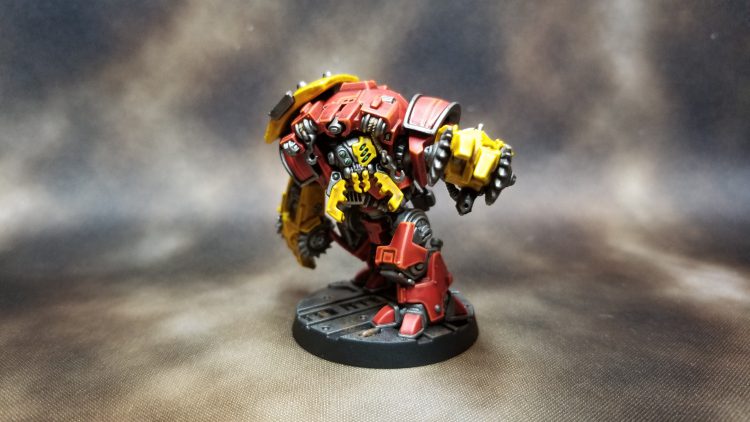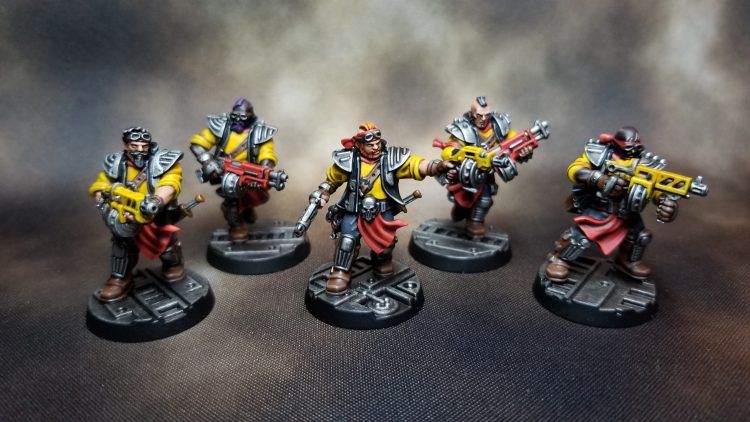Greetings Hive Dwellers! This week we’re going away from the battlefields of the 41st Millennium and instead diving deep into the underhive of Necromunda. Readers of our Necromunday column are already familiar with the INCREDIBLY AWESOME game of squad level hive combat, but if you’re not I highly recommend giving it a shot. It’s one of the best games Games Workshop has ever made.

Killing Stuff in the Underhive
The rules of Necromunda are based off of Warhammer 40K with a few additions to represent the more granular level of combat. The game uses a series of independent driving and gatekeeping probability checks to determine the final outcome, and those probabilities are most d6 based.
Wounds Taken = Attacks x P(Hit) x P(Wound) x [1 – P(Save)] x Damage
So far so good. Where things get interesting is that when the target is reduced to 0 wounds it is not automatically removed from play. Instead the player rolls an Injury die. 33% of the time the model’s Toughness characteristic is degraded from a Flesh Wound (FW), 50% of the time the model is Seriously Injured (SI) and can do nothing but crawl and pray it recovers before someone stabs it to death, and then 17% of the time the model is Out of Action (OOA) and removed from play. If the model receives enough Flesh Wounds to reduce its T to 0 then it automatically goes Out of Action. When Seriously Injured the model rolls an Injury die in the End phase and applies the result, hoping for a Flesh Wound so it can stand up and fight.
So how do we work out the probability of dying?
Eventually the player will roll something other than a SI result on a Recovery test. Two thirds of the time that inevitable result will be a FW, and the remaining one third of the time it will be OOA. So looking at the original Injury die and splitting the SI result in the probabilities of FW and OOA we can expect the following results:
P(FW) = (2/6) + (3/6)*(2/3) = 4/6
P(OOA) = (1/6) + (3/6)*(1/3) = 2/6
So a given Injury will, on a long enough timeline, result in a FW two thirds of the time and OOA the remaining one third. These results are further complicated by the fact that SI results do not stack; once a player is SI additional SI results are ignored (but they can take additional FW or go OOA).
We can use this information to determine the number of Injury rolls that, on average, will take the target out. For a T1 target a single Injury roll is all that’s needed since no matter what it will go OOA. For a T2 target a single Injury roll will be needed one third of the time, and two rolls will be needed two out of three times for an average of 1.67 rolls. The chart below gives you the probabilities that the given number of injury rolls will take out the target.

Multiply the probabilities by the number of rolls and you get that you want to deal around 3 injury rolls to nearly everything in order to have a good chance of knocking them OOA. As I said before this does not take into account the fact that, against a SI target, the result is ignored half of the time. In that case it’s in your best interest to roll up and stab them. The fact they ignore Injury dice entirely makes Sever and Melta weapons particularly terrifying.
As an example, let’s look at what happens when we injure a common T3 target. The first Injury roll, when the target hits 0 wounds, will produce an OOA result one in six times. One in three times a FW will occur. The rest of the time the model will be seriously injured. If we let the model writhe around and scream in pain until nature takes it course, eventually the model will either go OOA or get a FW. When you add those probabilities up you get that the first Injury roll took the target out 33% of time time, and 66% of the time you have to hit it again. So you force another Injury roll, and one of three times that second roll is enough to knock it OOA. One third of 66% is 22%, so 22% of the time 2 Injury rolls will take out the target. The remainder of the time you’ll need that third Injury roll since it’s a T3 target.
The Joys of Blast Weapons
Blast weapons like grenade launchers are very, very good in Necromunda. They allow players to ignore the targeting priority rules and instead place a blast marker anywhere within line of sight, and instead of missing entirely if the hit roll is failed the weapon scatters. So long as the model’s base is underneath the blast marker after scattering the weapon hits the target. As a result there are three results that can cause the target to take a hit:
- The hit roll succeeds.
- The d6 result on the Scatter test is low enough that the blast marker still covers the base.
- The blast marker scatters into a wall and the position is close enough to cover the base.
It’s impossible to calculate every scenario regarding walls, but it can have a pivotal effect particularly in Zone Mortalis games. For scattering in the open, models in Necromunda generally have 25mm (0.984”) or 32mm (1.260”) bases, and the radius of the blast markers (half the diameter) is either 1.5” or 2.5”. If you place a blast marker on the center of a model’s base, it will need to scatter a distance equal to the radius of the blast marker plus the radius of the base. The radius of a 25mm base is less than half an inch, while everything else is greater than half an inch, so size matters.

To go through the math, we consider the two possible outcomes. For the BS 6+ shooter targeting a 25mm model the chances of hitting are 16.7%. The chance of the blast scattering only one inch is the chance of the miss (5/6) multiplied by the chance of a 1 on the d6 (1/6), which is also 13.9%. Add the values together and after rounding you get a 31% hit chance.
The benefit is significant, with even the worst possible shooter still hitting a Goliath nearly half the time. Of course the low BS guys who benefit the most (Goliaths) also end up being the most vulnerable so at least there’s some balance. This also explains why combining the Overwatch skill with a grenade launcher is so devastating; a high BS champion like a Genestealer Acolyte Hybrid is going to pin and cancel your action three times out of four. The only way things get any easier is with template weapons, which are amazing in and of themselves.
Wrapping Up

Hopefully the information above will be useful for aspiring and veteran gang leaders alike. I found the stats on Blast weapons particularly interesting and this definitely won’t be the last article I do on Necromunda. It’s an amazing game that’s easily one of the most enjoyable ways to play with the small, jewel like objects of magic and wonder we call Citadel miniatures. If you’re interested I highly recommend checking out our Necromunday series. Dan and Merton are absolute fanatics about this game and are a fantastic resource.
If you have any comments or questions, feel free to drop a note in the comments below or email us at contact@goonhammer.com. If you have any questions that you would like answered, please submit them here.


